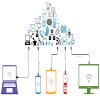What is an enterprise solution?
Enterprise Solution is a collection of computer services that have common business applications, tools for modelling how the entire organization works, and development tools for building applications unique to the organization. The software is intended to solve an enterprise-wide problem, rather than a departmental problem. Enterprise level software aims to improve the enterprise’s productivity and efficiency by providing business logic support functionality.
According to Martin Fowler, “Enterprise applications are about the display, manipulation, and storage of large amounts of often complex data and the support or automation of business processes with that data.”
Although there is no single, widely accepted list of enterprise software characteristics,they generally include performance, scalability, and robustness. Furthermore, enterprise software typically has interfaces to other enterprise software (for example LDAP to directory services) and is centrally managed (a single admin page, for example).
Enterprise application software performs business functions such as order processing, procurement, production scheduling, customer information management, energy management, and accounting. It is typically hosted on servers and provides simultaneous services to a large number of users, typically over a computer network. This is in contrast to a single-user application that is executed on a user’s personal computer and serves only one user at a time.
Enterprise systems (ES) are large-scale enterprise software packages that support business processes, information flows, reporting, and data analytics in complex organizations. While ES are generally packaged enterprise application software (PEAS) systems they can also be bespoke, custom developed systems created to support a specific organization’s needs.
Types of enterprise systems include:
enterprise resources planning (ERP) systems,
enterprise planning systems, and
customer relationship management software.
Although data warehousing or business intelligence systems are enterprise-wide packaged application software often sold by ES vendors, since they do not directly support execution of business processes, they are often excluded from the term.
Enterprise systems are built on software platforms, such as SAP’s NetWeaver and Oracle’s Fusion, and databases.
From a hardware perspective, enterprise systems are the servers, storage and associated software that large businesses use as the foundation for their IT infrastructure. These systems are designed to manage large volumes of critical data. These systems are typically designed to provide high levels of transaction performance and data security.
Enterprise software can be categorized by business function. Each type of enterprise application can be considered a “system” due to the integration with a firm’s business processes. Categories of enterprise software may overlap due to this systemic interpretation. For example, IBM’s Business Intelligence platform (Cognos), integrates with a predictive analytics platform (SPSS) and can obtain records from its database packages (Infosphere, DB2). Blurred lines between package functions make delimitation difficult, and in many ways larger software companies define these somewhat arbitrary categories. Nevertheless, certain industry standard product categories have emerged, and these are shown below :
Business intelligence
Business process management
Knowledge Management (KM)
Customer relationship management (CRM) - (commonly used in smaller organisations too)
Database - such as Master data management (MDM) and Data Warehousing
Enterprise resource planning (ERP) - which is a broad category covering: Accounting, Human Resource, Corporate performance and governance, Customer Services, Sales, Procurement, Production, Distribution
Enterprise asset management (EAM)
Low-code development platforms (LCDP)
Supply chain management (SCM)
Product data management (PDM)
Product lifecycle management (PLM)
Networking and Information Security
Software Defined Networking (SDN) - including SD-WAN
Intrusion Detection and Prevention (IDS)
Others that don't fit into well-known standard categories, or isn't limited to Enterprise use - Backup software, Billing Management, Accounting software, Content management system (CMS)'''),
'power-of-ai': Blog('assets/blog/bi.jpeg', 'Business Informatics:Power of AI', ' ', '''
### Business Informatics
Business Informatics shows similarities to information systems (IS), which is a well established discipline originating from North America. However, there are a few differences that make business informatics a unique own discipline:
Business informatics includes information technology, like the relevant portions of applied computer science, to a larger extent than information systems does.
Business informatics includes significant construction and implementation oriented elements. I.e. one major focus lies in the development of solutions for business problems rather than the ex post investigation of their impact.
Information systems (IS) focuses on empirically explaining phenomena of the real world. IS has been said to have an “explanation-oriented” focus in contrast to the “solution-oriented” focus that dominates BI. IS researchers make an effort to explain phenomena of acceptance and influence of IT in organizations and the society applying an empirical approach. In order to do that usually qualitative and quantitative empirical studies are conducted and evaluated. In contrast to that, BI researchers mainly focus on the creation of IT solutions for challenges they have observed or assumed.
Tight integration between research and teaching following the Humboldtian ideal is another goal in business informatics. Insights gained in actual research projects become part of the curricula quite fast because most researchers are also lecturers at the same time.[2] The pace of scientific and technological progress in BI is quite rapid, therefore subjects taught are under permanent reconsideration and revision.[3] In its evolution, the BI discipline is fairly young. Therefore, significant hurdles have to be overcome in order to further establish its vision.[4]


6 Comments
Leave a comment